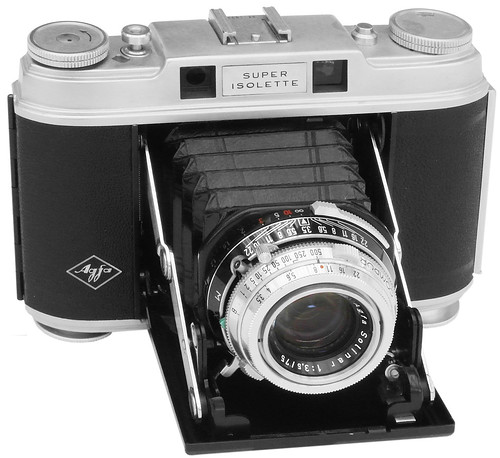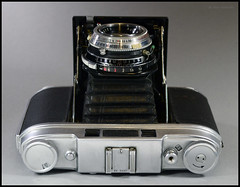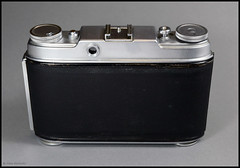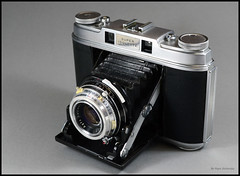Super Isolette

|
| image by Alf Sigaro (Image rights) |
The Super Isolette is a coupled-rangefinder camera for 6×6 cm pictures on 120 film, made by Agfa from 1954-60.[1]. "Super" refers to the addition of a coupled rangefinder, changes in the film transport and focusing system. The camera is an extension of the Isolette range of square-format folders; the Isolette III has an un-coupled RF; other Isolettes are all viewfinder cameras. However, the Super Isolette is very different from the other cameras, even though it was introduced only a little later than the Isolette I, II and III.
Besides a better fit and finish than all the other Isolettes: Focusing is performed by moving the whole front lens assembly instead of the front element, which is coupled via push-rod with the rangefinder. Film loading is semiautomated, and there is no red window in the back of the camera; the film is loaded in the camera and it advances until the 1st frame, then advances 1 frame at a a time. The double-exposure prevention interlock, has an indicator window by the shutter release. The film advance knob is on the right of the top housing. There is a film-type reminder on the left, in a knurled disc matching the film-advance.
The Super Isolette was only sold with a 75 mm f/3.5 Solinar (4 elements/3 groups), the highest-grade lens offered among Agfa's folders, that accepts 32 mm slip-on filters or 29.5 mm screw-in ones. The shutter is either a Synchro-Compur MX for the early cameras or a Synchro-Compur MXV, fitted on cameras after serial numbers somewhere in the 7xxx range. Both these shutters offer a B,1-500 speed range and are synchronised for flash.
The Super Isolette was sold in the USA as the Super Speedex. It was copied by KMZ as the Iskra.
  
|
| Agfa Super Isolette Images by Hans Kerensky. (Image rights) |
Notes
- ↑ McKeown, James M. and Joan C. McKeown's Price Guide to Antique and Classic Cameras, 12th Edition, 2005-2006. USA, Centennial Photo Service, 2004. ISBN 0-931838-40-1 (hardcover). ISBN 0-931838-41-X (softcover). p25.
Links
In English:
- Super Isolette profiled among other Agfa/Ansco folders, by Andrew Yue (archived)
- Notes on the Super Isolette and PDF User's manual for it at Certo6.com.
- Agfa Super Isolette on Pocketable History by J. Noir
- Super Isolette review by Ken Rockwell
In Spanish:
- Agfa Super Isolette on Historia de Bolsillo by J. Noir